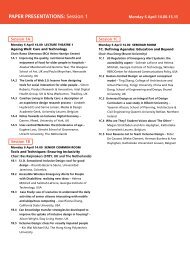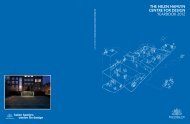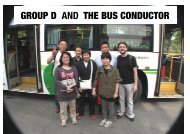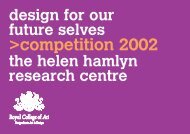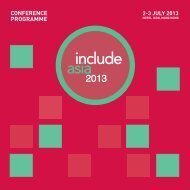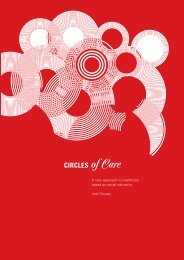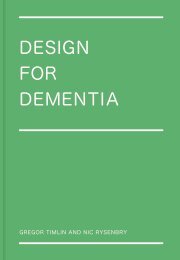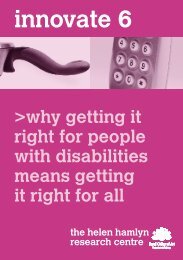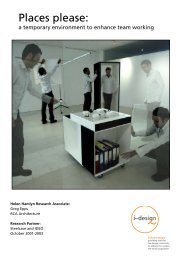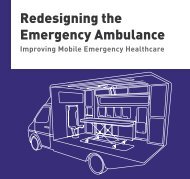Download in Adobe PDF format - Helen Hamlyn Centre - Royal ...
Download in Adobe PDF format - Helen Hamlyn Centre - Royal ...
Download in Adobe PDF format - Helen Hamlyn Centre - Royal ...
You also want an ePaper? Increase the reach of your titles
YUMPU automatically turns print PDFs into web optimized ePapers that Google loves.
two products – one well designed,<br />
the other poorly so. After analysis<br />
of their functional, emotional and<br />
aesthetic qualities, the students<br />
were split <strong>in</strong>to groups and asked to<br />
select a poorly designed product<br />
and redesign it to a deadl<strong>in</strong>e.<br />
The objects ranged from<br />
obstetric forceps and an army hide<br />
rucksack to a cruet set and pencil<br />
sharpener. After presentation of<br />
their proposals, participants were<br />
<strong>in</strong>troduced to some <strong>in</strong>clusive<br />
case studies and ‘quick and dirty’<br />
research methods, followed by a<br />
simulated experience of disability.<br />
They donned rubber gloves, taped<br />
up their f<strong>in</strong>gers, smeared grease<br />
on their glasses or wore those<br />
which simulated eye conditions and<br />
then handled the object they had<br />
redesigned.<br />
Then it was back to their draw<strong>in</strong>g<br />
boards for another redesign<br />
of the object with a presentation<br />
and judg<strong>in</strong>g. Their first redesigns<br />
showed an emphasis on style and<br />
aesthetics while the second leaned<br />
towards the importance of function.<br />
The question rema<strong>in</strong>ed as to how<br />
to seamlessly reconcile the two.<br />
After an <strong>in</strong>trodution to usercentred<br />
research methods, the<br />
students were given the brief for<br />
Day Two, to spend the morn<strong>in</strong>g<br />
captur<strong>in</strong>g user data <strong>in</strong> a supermarket,<br />
restaurant, home or public<br />
transport term<strong>in</strong>al. They had to<br />
observe an <strong>in</strong>dividual or group<br />
<strong>in</strong>teract<strong>in</strong>g with a product, service<br />
or environment, document them<br />
us<strong>in</strong>g sketch<strong>in</strong>g, video ethnography,<br />
still photography and f<strong>in</strong>d<br />
issues that could be addressed<br />
through design.<br />
Day Two: field work and<br />
storyboard<strong>in</strong>g<br />
The students spent the morn<strong>in</strong>g<br />
observ<strong>in</strong>g <strong>in</strong>dividuals <strong>in</strong> different<br />
contexts. In the afternoon, they<br />
were shown how to isolate a key<br />
design issue, build a narrative<br />
around their f<strong>in</strong>d<strong>in</strong>gs and present<br />
it <strong>in</strong> storyboard form, giv<strong>in</strong>g the<br />
context of the person or group that<br />
<strong>in</strong>spired it.<br />
An <strong>in</strong>troduction to the concept<br />
of multiple scenarios followed. It<br />
is central to understand<strong>in</strong>g how<br />
a product or service <strong>in</strong>spired by<br />
disability or extreme needs can be<br />
made relevant to different groups<br />
<strong>in</strong> the population. By identify<strong>in</strong>g<br />
how superficially disimilar activities<br />
by diverse groups of people are<br />
43



